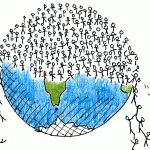By Andriana Aggelopoulou (A class)
People with disabilities are one of the most marginalized groups of any society. Although the international human rights regime has greatly improved people’s lives around the world, people with disabilities have not benefited fully from this protection. In general, these people are the last on the list of protection of fundamental rights and freedoms, irrespective of the level of protection and economic situation in each country. The United Nations Convention ensures that the «largest minority of the world» enjoys the same opportunities and enjoys the same rights as any other person. It covers most of the areas in which people with disabilities have suffered discrimination, including access to justice, participation in political and public life, education, work, freedom from torture, exploitation and violence, as well as freedom of movement. The Convention also recognizes that some categories of people are subject to discrimination, not only on the basis of their disability but also on the basis of gender, age, or other reasons. Thus, it includes two articles devoted to specific people: women with disabilities and children with disabilities. At the same time, the Convention marks the exemplary change in the prevailing disability approaches.
The focus of the problem is no longer identified in the individual, with disability being treated as a «defect», but in the structure of society because of its failure to incorporate human diversity. In particular, according to UNICEF’s annual report on the situation of children in the world today, children with disabilities are less likely to receive health care or go to school while being among the most vulnerable to violence, abuse, exploitation and neglect, especially if they are placed in institutions, because of the financial cost of their upbringing. The final result is that children with disabilities are among the most marginalized people in the world. Children living in poverty are less likely to go to school or have medical care, but those who, besides poverty, have a disability are even more at risk. Gender is also a basic parameter as girls with disabilities are less likely than boys to receive food and care. As the above report indicates, focusing on the abilities of children with disabilities will create benefits for society as a whole. When these children are fully involved in society, they all benefit. For example, inclusive education widens the horizons of all children while offering opportunities for children with disabilities to fulfill their ambitions. Increasing efforts to integrate these children will make a significant contribution to combating discrimination, which leads them to marginalization.
Flashback
Approximately 20 years ago, the size of the global marginalization of the people with disabilities was large. People with disabilities usually lived in miserable conditions because of the existence of physical and social obstacles; as a result, millions of those people were separated from society, deprived of almost all their rights and lead a pathetic, marginalized life. Prior to the presentation of the UN Convention, the international protection regime emerged from the need to safeguard marginalized abusive and exploitative practices similar to those that occurred in the years before and during the Second World War. Despite the fact that people with disabilities were accused of being subjected to brutal persecution and extermination during this period of time, there was little mention of them.
In 1971, the UN General Assembly adopted the Declaration on the Rights of Persons with Mental Disabilities. This Declaration has signaled a growing awareness of the need to protect the rights of people with disabilities by predicting that people with intellectual disabilities enjoy the same rights as any other person. However, there were no detailed instructions for achieving objectives, and the existence of phrases such as «as much as possible», in the provisions of the Declaration potentially allowed a lower level of protection.
Then, in 1975, the General Assembly proclaimed the Declaration of the Rights of Persons with Disabilities. The primary objective was to confirm that people with disabilities enjoy the same rights as others, presenting the first explicit UN recognition of the rights of people with disabilities as a group. The Declaration provided for measures that would promote the autonomy of the Disabled.
A few years later, in 1982, the GA adopted the World Action Program on Disabled Persons, the aim of which was to promote full participation and equality in social life and development, addressed to all states, regardless of their level of development.
At the same time, the General Assembly declared the 1983-92 decade as the «UN Decade for People with Disabilities», encouraging Member States to implement the objectives of the Global Program of Action. During this decade, the GA adopted two important texts. The first seeks to encourage states to promote the participation of people with disabilities in society by removing natural and communicational obstacles, securing opportunities for education, training and work, and by raising awareness of the needs and potential of these people. As regards the second text, it establishes standards of medical care and procedural safeguards to protect people with mental illnesses from the most serious human-rights violations that can take place at institutional level such as bad or unfair use of restraint methods, sterilization, surgical procedures and other irritating and irreversible approaches for the treatment of mental disability. Despite the innovation of the authorities at the time of their adoption, their value today is being questioned.
The end of the Decade of the Disabled People was sealed with the adoption by the GA of the non-binding «Standards of Equal Opportunities for People with Disabilities» in 1993. The Standard Rules, 22 in number, are divided into three major groups: the first focuses on the conditions for (such as rehabilitation and medical services); the second on specific areas where participation and access should be ensured (for example, in the urban environment, work, education); and the third group on the issue of implementation rules, by including and involving the organizations of the Disabled. The Standard Rules, although making quite clear statements about the rights of the Disabled and promoting the creation of an environment accessible to everyone, continue to focus on medical care and prevention as a prerequisite for equal participation. This has been the subject of strong criticism by the supporters of the rights of people with disabilities due to the failure of the rules to link disability to human diversity and respect for the inherent dignity of people with disabilities. The Standard Rules were the basic tool in the hands of the UN that regulated the action of states on human rights in the area of disability while at the same time they were an important point of reference for identifying the obligations of the states. Indeed, many states have used the Standard Rules as the basis for their internal legislation. However, notwithstanding the provision for a special referee responsible for monitoring the application of these rules at national level, the latter did not have binding force for the Member States, with the result that their effect is generally limited.
The Right to Participation-Accessibility of People with Disabilities
The principle of accessibility aims to remove the obstacles that society puts in place and prevent the enjoyment of human rights by the Disabled. The principle refers not only to physical access to premises but also to access to information, technologies such as the Internet, communications, and economic and social life. Provision of ramps, large corridors, doors and handles for disabled people, the provision of Braille or sign language information but also other readable forms, the existence of interpreters and the provision of assistance and support can provide access for disabled people to workplace, entertainment, transportation, courts etc. Indeed, the inability to access information and freedom of movement necessarily leads to the restriction of other rights of people with disabilities, namely:
- The right to individual autonomy: a person with a physical disability should be equipped with the necessary mechanisms to facilitate his movement in order to enjoy the greatest possible independence.
- The right to equal opportunities: For example, if a polling station is remote from the place of residence or there are no ramps in it, a wheelchair person may be prevented from exercising his or her electoral right. Also, in the case of a blind person, voting material should also be printed in Braille. However, most of the time the implementation of the above principle requires special intervention by the state.
Respect for diversity implies accepting others in the light of mutual understanding. It includes accepting disability as a part of human diversity. All people enjoy the same rights and have the same dignity, despite their differences. Solutions should be specific for each person and may include changing practices, spending money on additional equipment, supporting or improving access facilities. With regard to movement, for example, the driver of a bus, before leaving the station, must give a person with a physical disability the appropriate time to board it, but also to get to it. Not only should the bus driver ensure the highest quality and safety of transport for all, but also the bus routes should take into account the various factors, including the needs of the disabled. As far as the workplace is concerned, and in the event that, for example, a worker suffers an accident, inside or outside the workplace, resulting in a physical disability, which then implies the use of a wheelchair, the employer bears responsibility for the ramp installation, the construction of a toilet for the disabled, the creation of clear passageways, as well as any other adaptation and modification, so that the person can continue to work as an active worker.
The United Nations Convention
The Convention covers all the individual, political, economic, social and cultural rights. The Convention does not guarantee new rights but analyzes what these rights mean in the case of the Disabled and clarifies the obligations of States to protect and promote their rights. Indeed, in order to ensure a favorable environment for their achievement, the Convention contains provisions on social awakening, accessibility, risk situations and humanitarian crises, access to justice, individual mobility, empowerment and rehabilitation. Article 5 (par.2) of the Convention provides for the prohibition of discrimination on grounds of disability by the Member States, while Article 2 defines discrimination on the grounds of disability as «any discrimination, exclusion, or restriction which has as its object or effect the prevention or annulment recognition, enjoyment, or practice on equal terms of all rights and fundamental freedoms in a political, economic, social, cultural, individual, or any other field. It includes all forms of discrimination, including denial of reasonable accommodation».
For the most part, the Convention imposes an obligation to identify obstacles to the enjoyment of human rights by the Disabled and to take appropriate measures to remove them. The emphasis is on the particular person with a disability rather than on a group. The Convention explicitly recognizes the rights of people with disabilities in political life, through, for example, the right to vote in parliamentary elections, but also in cultural life, through supporting participation in cultural, sporting and other recreational activities.
The Case of Greece
Greek Legislation for People with Disabilities
The Greek Constitution states in Article 4 that Greeks are equal before the law and that Greeks have equal rights and obligations. This article establishes the principle of equal treatment of people with disabilities in relation to the law, as well as the principle of gender equality. This constitutional enshrinement of the principle of equality before the law is the cornerstone of the regulatory framework for people with disabilities and their treatment by the state, while the principle of gender equality ensures that women with disabilities are equal members of society and protected from the state as well as men with disabilities. According to Article 21 (par. 2) of the Constitution, families of many generations, war and peace-loving peoples, war victims, widows and orphans who have fallen into war, as well as those suffering from incurable physical or mental illness are entitled to a special treatment and in accordance with paragraph 3, the state ensures the health of citizens and takes special measures to protect youth, old age, disability and take the care of the most deprived. Article 21 (par. 6) also explicitly refers to the rights of persons with disabilities, stating: «Persons with disabilities have the right to enjoy measures that guarantee their autonomy, integration and participation in the social, economic and political life of the Country».
Accessibility of people with disabilities in Greece
Greece is not considered a fully accessible country, as this does not allow in many cases to shape its territory. Despite the large number of visitors with special needs, its cities and villages do not have full accessibility and adequate infrastructure. Of course, this is not the case with all its regions. There are infrastructures designed to meet the needs and desires of every visitor who will definitely want to visit again in the future. As far as Greece is concerned, there are (even a few) infrastructures and organized cities, beaches, activities and businesses for people with disabilities, but they are not known to the target audience.
In our city of Patras, people with disabilities are facilitated by pedestrian walkways with appropriate inclination, disabled parking spaces, the accessible Patras Museum, the accessible exhibition center of the Rio-Antirion Bridge and selected accessible dining areas.
The city of Komotini has made excellent progress and is the standard city of accessibility, where many wheelchair users move permanently from elsewhere in Greece to improve their quality of life. The sidewalks have been formed with the right width and ramps with the right slope. Some places of mass catering have a suitable ramp at the entrance, while most public services provide access to everyone and all of them are accompanied by appropriate disabled parking spaces.
In Kos, good work has been done as well, as there are suitable bicycle lanes where trolleys can be driven, an accessible beach with suitable facilities and a total of five hotels with suitably designed wheelchair rooms. Also in certain tourist attractions there is easy access. Several other cities like Loutraki, Thessaloniki and Chania are similarly good examples.
Loutraki

Chania

Thessaloniki
For daily excursions to nature and for those who are in Thessaloniki, the mountain shelter «Chortiatis» is offered. Through specially designed holiday and recreation programs for people in need of increased care for people with disabilities, the necessary tools are provided (electric or manual trolleys), equipment for activities, transportation, as well as 24-hour health care.

The Case of the United Kingdom
Let us see the extent to which the UK is putting the UN Convention on the Rights of Persons with Disabilities (CRPD) into effect.
The UK and devolved governments are expected to adopt action Plans that identify barriers to accessibility for disabled people; set time frames with specific accountable deadlines; and provide both human and material resources In light of plans to exit the EU, the UK Government should pass parallel legislation on accessibility, setting standards in goods and services, in accordance with Article 9 and drawing on EU models.
London is one of the wealthiest cities in the world. Yet many transport services remain out of bounds for its Disabled and older citizens. Physical barriers like flights of stairs, gaps and obstacles combined with the way transport services are run prevent many of us from getting out and about and living their lives. They want to live, work and enjoy their lives in a capital that is accessible to all. Access to transport is vital in making this happen.
The UK and devolved governments should:
- Introduce national targets to ensure that new housing is increasingly accessible or adaptable for disabled people, and ensure the built environment is accessible and allows disabled people to live independently, reviewing and revising the planning framework where necessary.
- Review the current planning framework in England to ascertain whether it facilitates compliance with the CRPD obligation to ensure accessibility in relation to housing particularly in older housing stock.
- Encourage local authorities in England to follow the example of London and use optional Building Regulations to increase the provision of accessible and adaptable housing.
- Monitor the impact of housing standards in providing appropriate, accessible housing for disabled people.
- Ensure that all transport and transport infrastructure is accessible to disabled people.
- Ensure that personnel of all public transport providers are equipped with the skills and knowledge to assist disabled passengers.
- Ensure that all new buses and trains provide accessible real time travel information.
- Set a target date by which all rail stations in the network should be accessible, focusing on the accessibility of journeys, not just of stations.
- Ensure that all communications (including online forms) of public authorities or those of their contracted providers are accessible to disabled people.
- Take all appropriate steps to ensure barriers to accessing the Internet for disabled people are removed.
- Remove barriers in communication between Deaf / deaf-blind people and their families, careers, education & healthcare staff and public-service providers.
- Support to undertake courses for Deaf / deaf-blind communication skills

Instead of conclusion
With full membership, disabled people are recognized and valued as equal members. Their needs are perceived as an integral part of the community and are not classified as «special». The above principle therefore aims to involve people with disabilities in the wider society and to make decisions about them, by encouraging them to define their own lives.




Bibliography:












